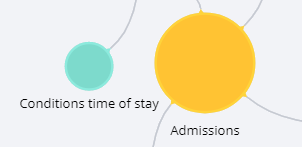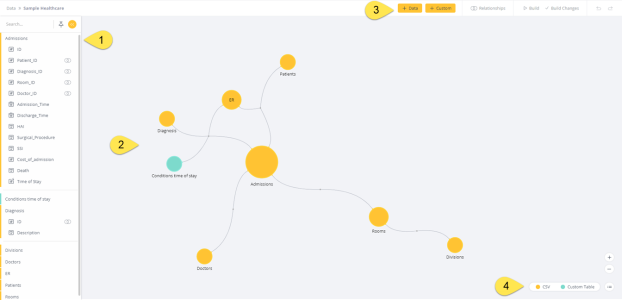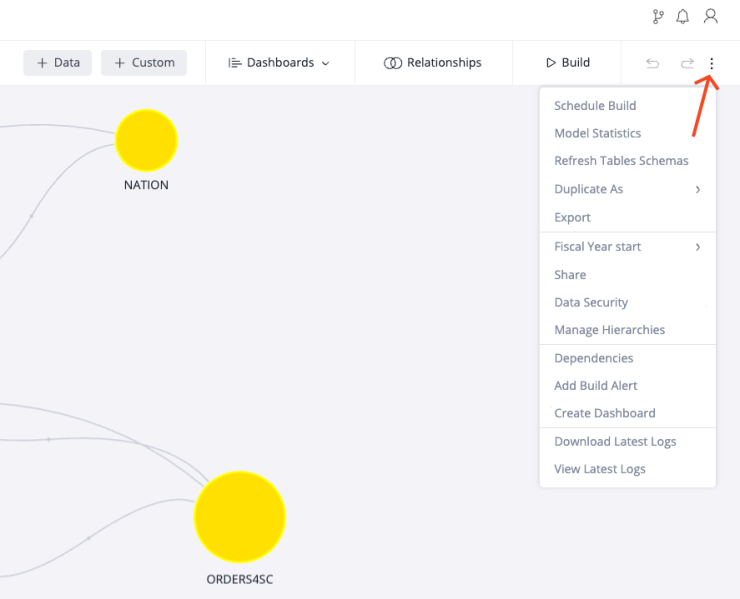Navigating the Model Editor - Overview
The first time you create an ElastiCube or a Live data model, it's empty until you start adding some data. Once you connect to your data source and select what data is going to be imported or queried, it's represented in Sisense as circular nodes. Each node is a table. The color of a node is determined by its data source. For example, data imported from a CSV file is one color, while data imported via SQL is another. The colors of the data source are described in the legend on the bottom right of the editor.
The size of the table reflects the number of relations and the number of columns the table has. So, a table with several relations and a lot of columns will be larger than a table with a single relation and fewer columns. For example:

The "Conditions time of stay" table is a custom table with a single relation and the "Admissions" table contains data from a CSV file and has four relations.
The Model Editor contains a variety of information and functionality that lets you prepare your data model as needed. An example is shown below.

-
Navigation Pane: A list of your tables and their columns. On the left side of the table name is an icon that indicates what type of data is included, Date, Numeric or Text. On the right side is a join icon
 when the column is connected to another table.
when the column is connected to another table.For more information, see Finding Tables and Columns.
-
Schema: The schema contains your data model that represents all the data to be added to the ElastiCube and the relationships between the tables. Some of your tables might appear with icons attached to them. These indicate the status of your build and table. For example:
-
 indicates that the table has changed since the last ElastiCube build
indicates that the table has changed since the last ElastiCube build -
 indicates that a custom expression is currently in draft mode
indicates that a custom expression is currently in draft mode
See Working with ElastiCubes for more information.
-
-
Schema Menu: This menu lists the following buttons:
- Data: Add a new table to your ElastiCube.
- Custom: Add a custom table to your ElastiCube.
- Relationships: Open a preview window where you can join tables. See Creating and Removing a Relationship Between Tables for more information.
- Build: Initiate an ElastiCube build.
- Undo/Redo: Undo or redo any recent changes to your schema.
-
Legend: A description of the data sources in your ElastiCube, and the color that represents them in your schema.
Data Model Level Management Options
You can control and apply changes to the entire table model through the three-dots menu in the top-right corner of the data model editor.

| Menu Option | Description |
|---|---|
|
Query Settings |
Available for Live data models only. Defines query settings, such as result limit, query timeout, refresh rate, etc. See Live Model Query Settings. |
|
Schedule Build |
Available for ElastiCube data models only. Enables you to define an automatic schedule of the ElastiCube build. See Scheduling Builds. |
|
Model Statistics |
Enables you to collect statistics such as COUNT, COUNT DISTINCT, COUNT NULL, and more during build time or in an async task after publishing a model. See Model Statistics. |
|
Refresh Tables Schemas |
Update the schemas of all tables in the data model if there was a change to the data source, without having to add the table again. To refresh the schema of a specific table, perform the refresh from the table level menu. See Managing Tables and Columns. |
|
Duplicate As |
Make a copy of, or convert, the current data model to Live/EC. See Duplicating Data Models. |
|
Export |
Export the data model schema and/or data to a file saved on your computer. See Exporting and Importing Data Models. |
|
Discard Pending Changes |
Discard changes done in the data model and revert to the last built/published state. |
|
Fiscal Year Start |
Available for ElastiCube data models only. Change the default start of the fiscal year. See Changing Your Fiscal Year. |
|
Share |
Grant, revoke, or change access permissions for groups and users to the data model. See Managing Access to Data Models. |
|
Data Security |
Define data security rules for users or groups in this data model. See Data Access Security. |
|
Manage Hierarchies |
Set predefined hierarchies in the data model to be used in widgets. See Managing Drill Hierarchies. |
|
Dependencies |
See which analytical assets are built on the current data model. See Working with ElastiCubes. |
|
Add Build Alert |
Available for ElastiCube data models only. Notify selected users or groups when an ElastiCube build fails/succeeds. See Creating Build Alerts. |
|
Create Dashboard |
Create a dashboard based on the current data model. See Creating Dashboards. |
|
Download Latest Logs |
Available for ElastiCube data models only. Download the logs of the latest build of the current ElastiCube. See Working with Build Logs. |
|
View Latest Logs |
Available for ElastiCube data models only. See the logs of the latest build of the current ElastiCube. |